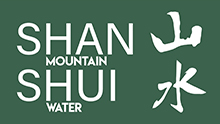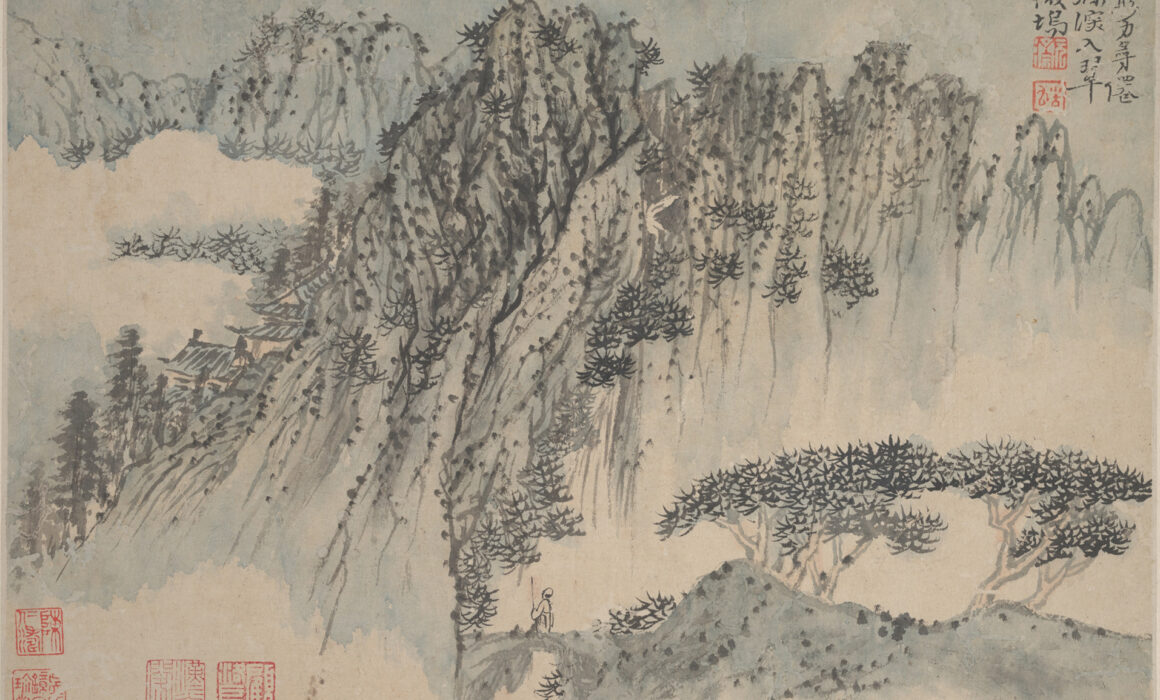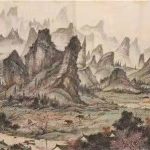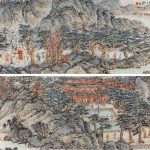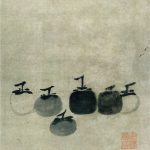Shitao 石涛 ’s Huayulu 《画语录》
Issue 3/4 – By; Claudio D. Lucchi
The Philosophy of Life in the Philosophy of Art in Shitao 石涛 ’s Huayulu 《画语录》
1. Introduction
Since its writing during the early Qing 清 dynasty (1644-1911), Shitao’s treatise on painting Huayulu 《画语录》[1] has never ceased to startle and fascinate generations of readers, artists, and scholars alike, through the shrewdness of its remarks on the very essence of the art of painting.
Although short in length, Shitao’s essay presents itself to the reader as a solid, well-rounded text that dives straight at the heart of its subject, bravely tackling a topic that had become highly critical in an era that saw Chinese mountain-and-water painting (shanshui hua 山水画) reach un-precedented heights of codification and conventionalisation, i.e., the very essence of painting, its origins, purpose, and meaning.
The Huayulu’s most prominent feature is, undoubtedly, its deep philosophical nature. This is not a unique characteristic per se. One would only have to go over some of the most important treaises composed in ancient times — such as Zong Bing 宗炳 ’s Hua Shanshui Xu 《画山水序》, Jing Hao 荆浩 ’s Bifaji 《笔法记》, Guo Xi 郭熙’s Linquan Gaozhi 《林泉高致》, or Shen Zong-qian 沈宗骞 ’s Jiezhou Xuehua Bian 《芥舟学画编》— to find out that they all touch, in one way or another, upon the philosophical nature of art. None of them, however, has gone so far as to treat the art of painting, even its most technical aspects, from a philosophical perspective. Through his bold and unconventional approach, Shitao’s artistic view finds its roots firmly planted at the origin of the universe, and expands itself way beyond the borders of the artistic field, thus reaching out into the infinite.
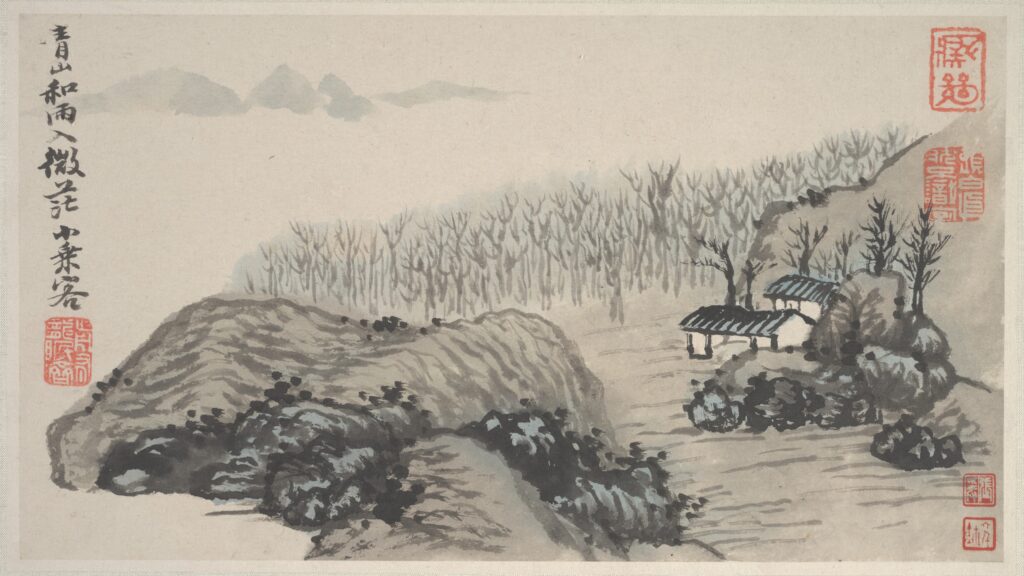
Album leaf, ink and colour on paper
21 x 31.4 Metropolitan Museum of Art
We should not be surprised to find that some of the ideas developed by Shitao reverberate throughout Henri Focillon’s Vie des formes (The Life of Forms in Art) and resonate in harmony with certain philosophical concepts put forth by Wassily Kandinsky in his monograph, Über das Geistige in der Kunst (Concerning the Spiritual in Art), and his 1912 essay, Über die Formfrage[2] (Concerning the Problem of Form).
In this sense, one may better understand why the Huayulu has been hailed by both Chinese and Western scholars as “one of the highest and most complete expressions of Chinese aesthetics”[3] . Its philosophical dimension turns it into a bridge, a platform on which Eastern and Western artistic thoughts and concepts may effectively meet and transform each other. Although they expressed themselves in distinctly different ways, and thus developed respective styles that were quite contrasting in both form and content, it may not be irrelevant to point out that Shitao and Kandinsky equally probed into the metaphysical nature of the art of painting, grounding their artistic corpus on a comprehensive philosophical system of thought. Both painters started from the finite and tended towards the infinite, and endeavoured to express “all variations through the invariable” [4] 不化而应化[5].
2. Prominence of Shitao’s Huayulu in Western studies.
A brief assessment of the position attributed to the Huayulu in the field of Western Chinese studies, and to existing translations and commentaries in particular, will amply illustrate the high es-teem in which this particular treatise is held by Western scholars. In English alone, Shitao’s treatise has already been translated over four times. In 1936, Osvald Sirén proposed a first partial translation in his study The Chinese on the Art of Painting: Translations and Comments (New York: Schocken Books, 1936, reprinted 1963), which he revised and presented again to his readers two decades later, in Chinese Painting, Leading Masters and Principles (New York: The Ronald Press Company, 1956-58, 7 vols.). A first unabridged translation by Lin Yutang 林语堂 was published in 1967, in The Chinese Theory of Art (New York: G.P. Putnam’s Sons, 1967).
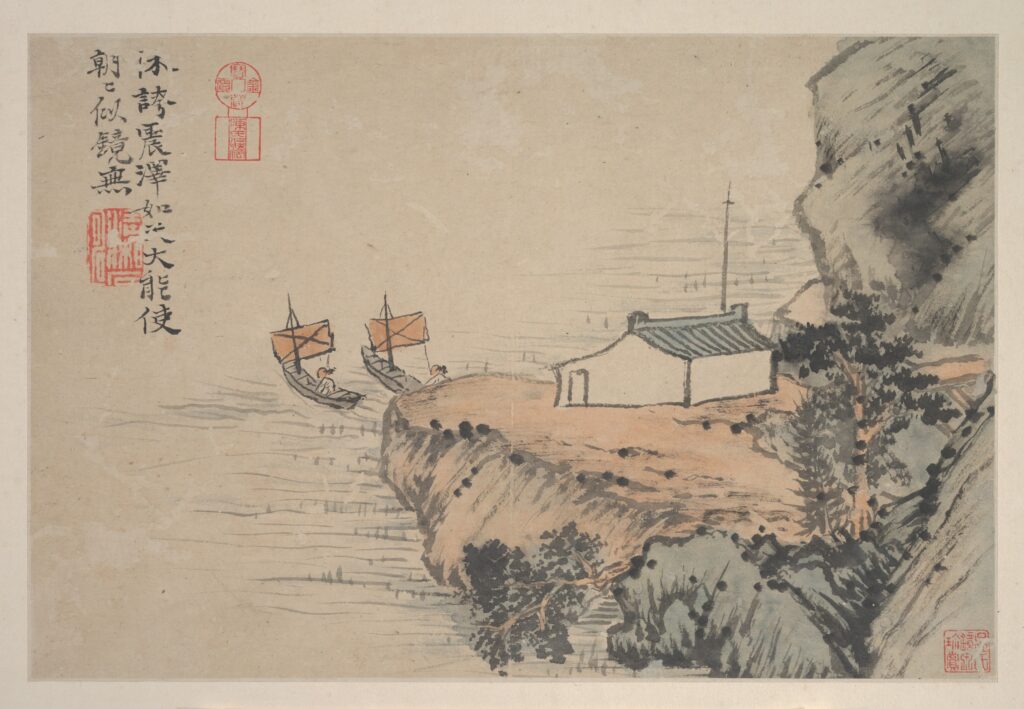
Dissatisfied with Sirén’s and Lin Yutang’s versions, which he regarded as “highly literal” for one, and as “highly literary”[6] for the other, Prof. Earle J. Coleman (Virginia Commonwealth Univer-sity, Department of Philosophy and Religious Studies) proposed a new translation of the Huayulu in 1978, with an in-depth, chapter by chapter analysis, which put particular emphasis on the treatise’s Taoist character and Shitao’s philosophy of art. Another distinguishing feature of Coleman’s version, in contrast with Sirén’s and Lin Yutang’s, is his choice to translate the Huapu 《画谱》 (Manual on Painting, dated 1710 and discovered in China in 1961) — instead of the previously translated Huayulu —, considered by some (including Prof. Coleman) to be a later and refined rendition of the original Huayulu[7]. When discussing purely painterly aspects, Coleman’s study may be found to be somewhat lacking in coherence. This may however be accepted as a minor excusable point, given that Prof. Coleman’s speciality was Chinese philosophy, and in this area, his monograph truly accomplishes the purpose it set out to conquer in the first place, videlicet to explore and expound the philosophical dimension of Shitao’s treatise.
In 1966, thus one year prior to the publication of the Huayulu’s first integral English version, the magazine Arts Asiatiques presented its readers with Les propos sur la peinture de Shi Tao, the treatises’s first French version, translated and thoroughly commented by Pierre Ryckmans. A more exhaustive version was later published under the title Les propos sur la peinture du moine Citrouille-Amère (Éditions Hermann, 1996). Les propos sur la peinture de Shi Tao remains to this day the only French translation of Shitao’s work and has been saluted as a brilliant work by François Cheng 程抱一, who quoted large extracts from it in Vide et plein: Le langage pictural chinois (Éditions du Seuil, 1991), a philosophical study of Chinese mountains-and-waters painting featuring a case study of Shitao’s oeuvre.
More recent translations of the Huayulu include Helmut Brinker’s German version, Aufgezeichnete Worte des Mönchs Bittermelone zur Malerei (Mainz: Dieterich’sche Verlagsbuchhandlung, 2009), as well as Discorsi sulla pittura del monaco Zucca Amara (Jouvence, 2015), a complete Italian translation by Marcello Ghilardi.
Among the monographs dedicated to Shitao and his art may be cited François Cheng’s Shitao: La saveur du monde (Phébus, 1998) and Jonathan Hay’s Shitao: Painting and Modernity in Early Qing China (New York: Cambridge University Press, 2001).
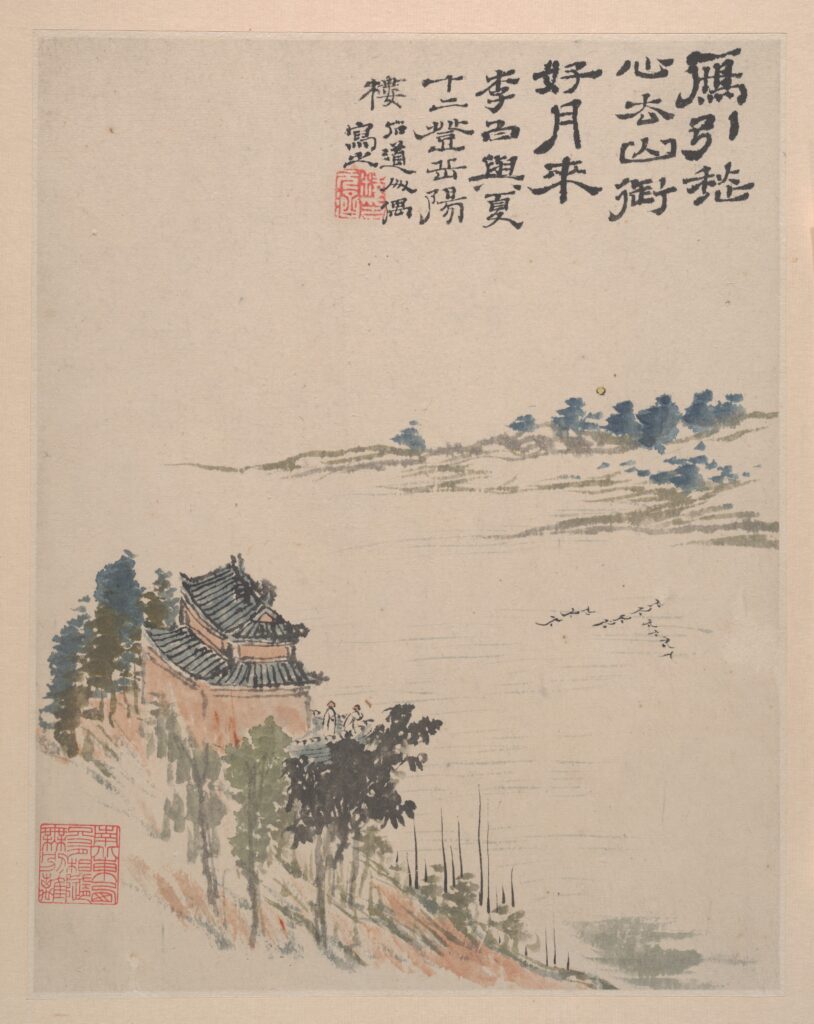
Perhaps one sentence by Pierre Ryckmans, from his opening remarks to his Les propos sur la peinture de Shi Tao, may best explain the reason lying behind this impressive corpus of translations and in-depth analyses that have been dedicated since the early twentieth century to this one single treatise on painting:
Le traité de Shi Tao occupe une place privilégiée dans l’ensemble des théories chinoises de la peinture: il se situe tout à la fois au terme et au sommet d’une longue tradition dont il rassemble les ri-chesses essentielles; puisant de manière syncrétique aux diverses sources de la pensée classique, il donne à la théorie picturale la forme d’une synthèse philosophique originale qui, de l’aveu général des critiques chinois et occidentaux, constitue une des expressions les plus hautes et les plus complètes de l’esthétique chinoise.[8]
Shitao’s treatise occupies a privileged place within the body of Chinese painting theory: it stands both at the end and at the top of a long tradition of which it brings together the essential riches; drawing in a syncretic fashion from the various sources of classical thought, it gives to the pictorial theory the shape of an original philosophical synthesis which is recognised by Chinese and Western critics alike as constituting one of the highest and most complete expressions of Chinese aesthetics.[9]
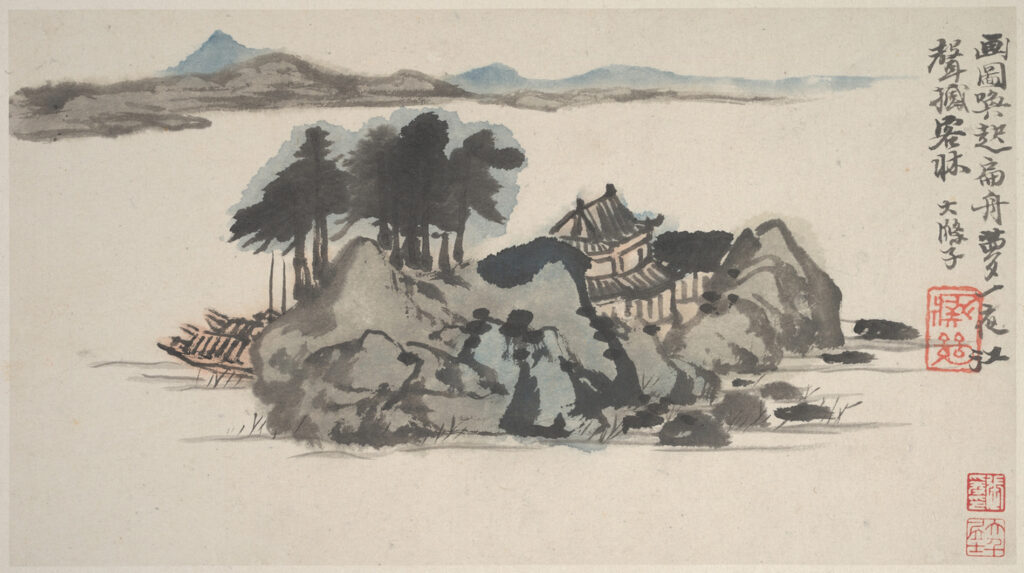
3. Tone and flavour of Shitao’s Huayulu
As one takes up the Huayulu, the uniqueness of its tone and nature, as well as its author’s literary disposition, reveal themselves instantly.
Contrarily to Zhang Yanyuan 张彦远, who greets the reader at the beginning of his Lidai Minghua Ji 《历代名画记》 with a few chosen words on the moral value of the art of painting, or Guo Si 郭思, who likewise unveils the Linquan Gaozhi 《林泉高致》 through a few general considera-tions on the role played by painting in a gentleman’s (junzi 君子) moral cultivation, Shitao dives straight at the heart of his subject, while simultaneously taking his reader back at the origin of the universe, revealing from the start his one-stroke concept (yihua 一画) and his metaphysical stance.
The Huayulu may indeed startle some by its detached, confident, and profound tone, yet marked in places by a flame of proud defiance mingled with hints of gentle mockery. Various scholars have both acknowledged the high artistic and literary value of the Huayulu, and found them-selves baffled by the great difficulty it posed during translation.
In The Chinese Theory of Art, Lin Yutang appraised Shitao’s treatise in the following terms:
It is completely original and shows a psychological insight into the process of artistic creation not found elsewhere in Chinese literature. In style, it is archaically beautiful, terse and taut with meaning, and very difficult to render into English. But of all Chinese essays on art, this is the most profound ever writ-ten, both as regards content and style.[10]
Osvald Sirén, on the other hand, while recognising the high value of Daoji 道济 [11] ’s essay, seems to have found its rendering into modern English rather an ordeal:
… the Hua Yü Lu is one of the most extraordinary contributions to the discussions of the theory and practice of painting, but couched in terms which, in part at least, offers evasive problems of interpre-tation. The terminology is largely borrowed from Taoist sources and it is applied with an abundant use of antitheses, repetitions and cosmological metaphors of a very abstruse kind.[12]
However, Sirén’s decision to abridge[13] the Huayulu, deeming a full version to be unnecessary and “hardly enjoyable to Western readers”[14], is highly deplorable, and denotes a mindset too preoc-cupied with issues strictly related to pure theory and art history to realise that an artistic essay, just like a work of art, is an attempt to reach the infinite and must needs be appreciated in its integrity in order to understand (emotionally as well as intellectually) its full scope and purpose.
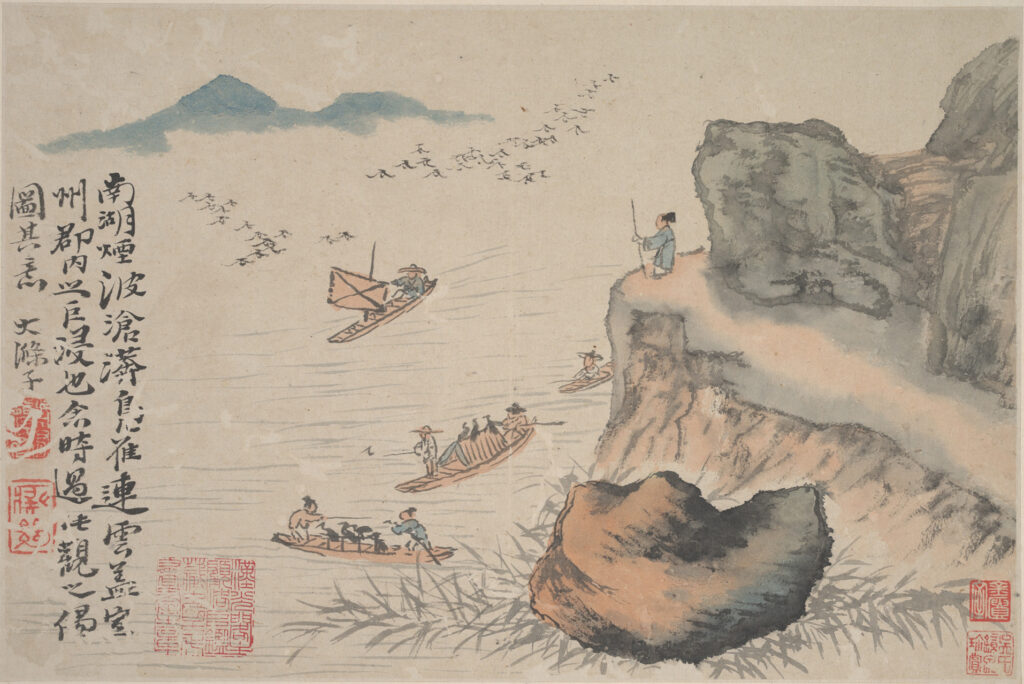
Truly, only a full text as provided by Pierre Ryckmans and Earle J. Coleman offers Western readers a chance to savour the dense and complex taste of Shitao’s treatise, along with its discreet hints and undertones.
The author of the present essay feels that even more than Prof..Coleman, it is Mr. Ryckmans who best succeeded in bringing out in his French version some of the particular literary flavours pre-sent in the original Chinese text, displaying in his chapter by chapter analysis an outstanding command of Chinese classic literature, philosophy, and painting.
Admittedly, any uninformed reader — that is, lacking a fundamental knowledge of classic mountains-and-waters painting literature, of Shitao’s work and life path, and of the main artistic trends of that period — might find it quite hard to appreciate the true value of the Huayulu. On the other hand, it would be a mistake to believe that a high level of specialisation in one particular field would allow a better reading of Daoji’s essay. Academic specialisation, as it is known today, is a rather recent phenomenon that became prominent only throughout the second half of the twentieth century. In the field of humanities, excessive expertise in one particular subject presents two main dangers: it may cause its practitioner to lose himself in abstractions, which could in turn lead to a very narrow and unilateral understanding of reality, or any given topic. More than specialisation, more than profound knowledge, what is required in order to enjoy an essay as unconventional and individualistic as the Huayulu is a creative mindset, a certain familiarity with the creative act, and a highly developed sensibility vis-à-vis the universe and emotional reality.
Without such characteristics, it would become difficult to grasp Shitao’s subtle and apparently conflicting undertones — all directly linked to his tormented and equally conflicted inner nature —, as he boldly unfolds the quintessence of his artistic and philosophical vision under the reader’s eyes.
Furthermore, one ought not to feel surprised or confused by the seemingly abstruse manner in which Shitao addresses his readers. Every painter knows that images reach way beyond the written word. Hence, it is never easy to discuss painting in writing. But besides this technical difficulty, there exists another reality that may elude the accomplished theorist, for it belongs to the painter’s whimsical nature: unlike academic scholars, painters are not necessarily keen to express themselves clearly, preferring to see their viewers toil to extract spiritual nourishment from their works. After all, what pleasure or sense of accomplishment is there in presenting the viewer with a ready meal?
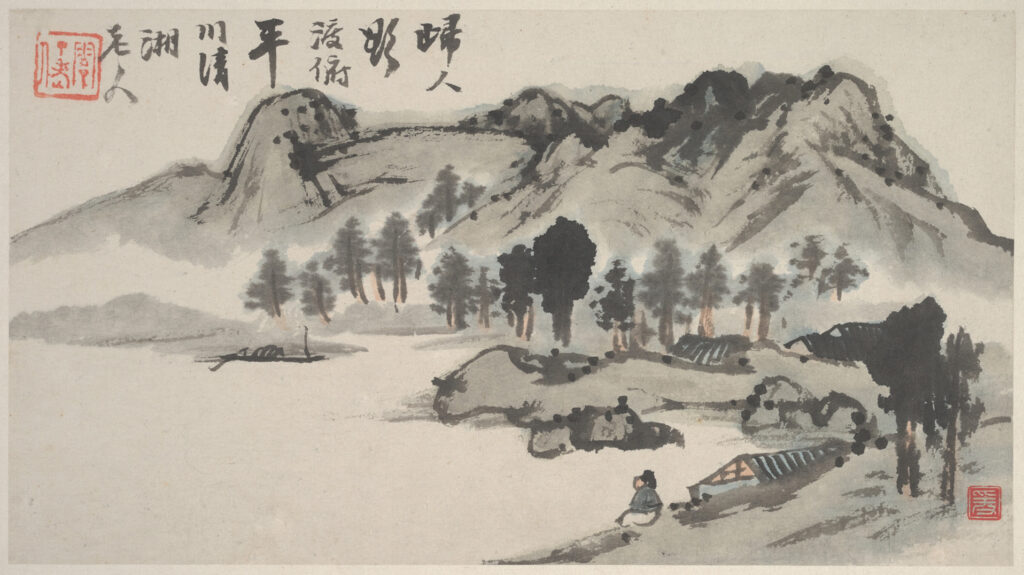
4. Philosophical nature of the Huayulu
《画语录》十八章是一个整体,是一个完整的有机的体系。从无到有,从简到繁,从一到万,逐渐发展,然后又从有到无,从繁到简,从万复归于一,层层统属。[15]
The Huayulu’s eighteen chapters constitute a whole, complete, and organic system. From nothing to existence, from simplicity to complexity, from one to ten thousand, it develops gradually, and then from existence to nothing, from complexity to simplicity, from ten thousand to one, it gradually re-cedes.[16]
Through the introductory lines of the Huayulu, Shitao takes his reader back, not to the root of the art of painting, but to the very commencement of all things. With a few well rounded sentences, he asserts that painting is not an activity or entity per se, but that it proceeds from Creation itself, to which it finds itself linked through the creative act. In other words, through brush and ink, the painter emulates the elementary process of creation. Seen under this light, painting is not a simple physical or intellectual activity; it becomes a form of life.
夫画:天下变通之大法也,山川形势之精英也,古今造物之陶冶也,陰陽气度之流行也,借笔墨以写天地万物而陶泳乎我也。[17]
Painting is the great way of the transformation of the world. The very essence of the conditions of mountains and rivers, the creation of nature (both ancient and modern), the movement of yin yang forces, all these are revealed through brush and ink; upon sketching heaven, earth, and the ten thousand things, their forms joyfully swim in my mind.[18]
Shitao regularly reasserts this fundamental concept throughout his essay, first “从无到有” (from nothing to existence), and then “从有到无” (from existence to nothing), as may be seen in the opening sentences of Chapter VII:
笔与墨会,是为氤氳。氤氲不分,是为混沌,闢混沌者,舍一画而谁耶?[19]
The union of brush and ink is that of yin and yun. The indistinct fusion of yin and yun constitutes the original chaos. How could one open up the original chaos, if not through the one-stroke? [20]
Having begun his most unorthodox essay with such elevated, philosophical considerations, Daoji naturally anticipated his reader’s astonishment, who, judging by the work’s title — Remarks on Painting —, possibly expected a more technical manual along the lines of the Xie Shanshui Jue 《写山水诀》, attributed to Huang Gongwang 黄公望. In Chapter VI, he thus addresses this issue in the following terms:
或曰:「绘谱画训,章章发明,用笔用墨,处处精细。自古以来,从未有山海之形势,驾诸空言,託之同好。想大涤子性分太高,世外立法,不屑从浅近处下手耶?」异哉斯言也!受之于远,得之最近;识之于近,役之于远。[21]
Some may say: ‘Painting treatises and drawing instructions manifest quite clearly the application of brush and ink, every detail being very carefully explained. Ever since the ancients, never before has painting the scenery of mountains and seas depended upon empty theories and the prejudice of one’s own preferences. I think Ta-ti-tzŭ’s individuality is too high, establishing a method beyond the world! Does he not disregard the simple rudimentaries?’
These words are strange indeed. Talent is from afar, but what one achieves is right at hand. If one grasps what is near at hand, then he can apply it to what is distant.[22]
At this point, one might assume that even the lofty Dadizi 大涤子[23] might have come to his senses and that from now on, he would duly entertain his reader with such technical questions as are conventionally required. Instead, as the following chapters unfold, the author further asserts his individualistic stance and tackles from a philosophical standpoint such technical topics as scenery (literally, mountains and streams, shanchuan 山川) and texture strokes (cunfa 皴法), seemingly oblivious of the recipe-like rhetoric common to various other manuals and treatises.[24]
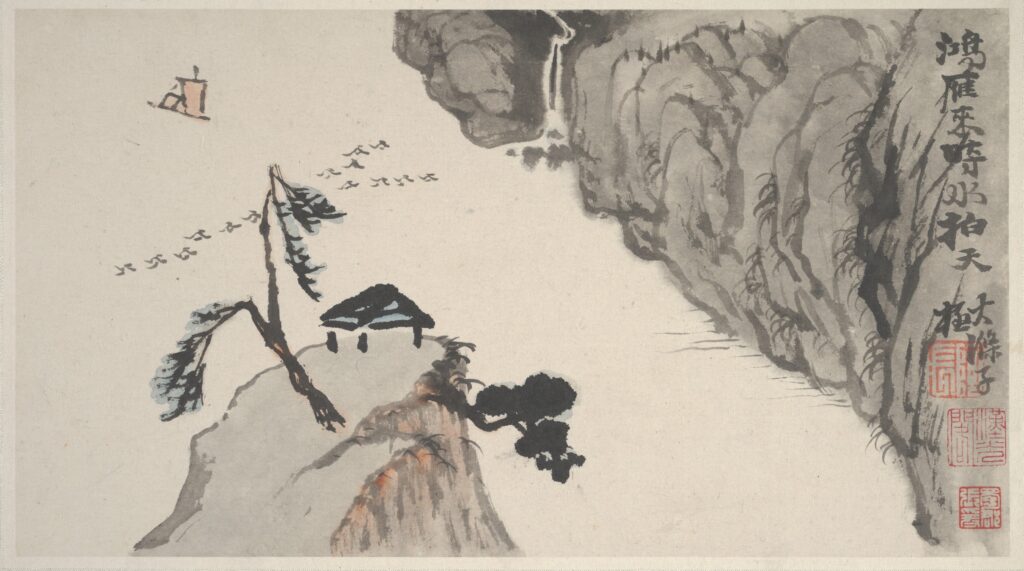
What transpires from the Huayulu’s short yet dense eighteen chapters is that Shitao mainly preoccupied himself with philosophical fundamentals, videlicet the unchanging principle of Life and of the universe. Compared to this, everything else is secondary and of lesser importance, for he who grasps that fundamental, invariable rule lying at the foundation of all variable transmutations present in our universe attains true enlightenment and thus holds the key to all truth. And with “enlightenment”, we mean not that inferior, technical understanding obtained through the systematic study of a given subject, but that higher, spiritual form of understanding, characterised by an ineffable sensibility towards all things. This idea is perhaps more explicitly expressed in Chapter XVIII:
古之人寄兴于笔墨,假道于山川。不化而应化,无为而有为。[25]
In the past, men expressed their feelings through brush strokes and ink wash by painting mountains and rivers. Their approach was to meet all variations through the invariable. They proceeded to action through non-action.[26]
He who is truly enlightened, and hence possesses the underlying truth of all things, is able to act through non-action (wuwei er youwei 无为而有为), i.e., in accordance with all things as they are, or, as Lin Yutang put it, “by the action of nature itself without human interference”[27]
Shitao did not despise the idea of the presence of rules and precise techniques in painting. As he remarked himself:
古之人未嘗不以法为也。無法則于世無限焉。[28]
The ancients did not work without rules. Absence of rules leads to absence of restraints in this world[29]
He did however fiercely disapprove of the institutionalisation of rules and techniques, and strongly warned of the dangers there are in blindly following any given rule without understanding the principle upon which it rests.
The Huayulu may be regarded as the distilled expression of Shitao’s lifelong meditations on the origin and meaning of Life and of his own life, sad meditations which may be found in a more spontaneous form throughout his correspondence and the colophons inscribed on his paintings.
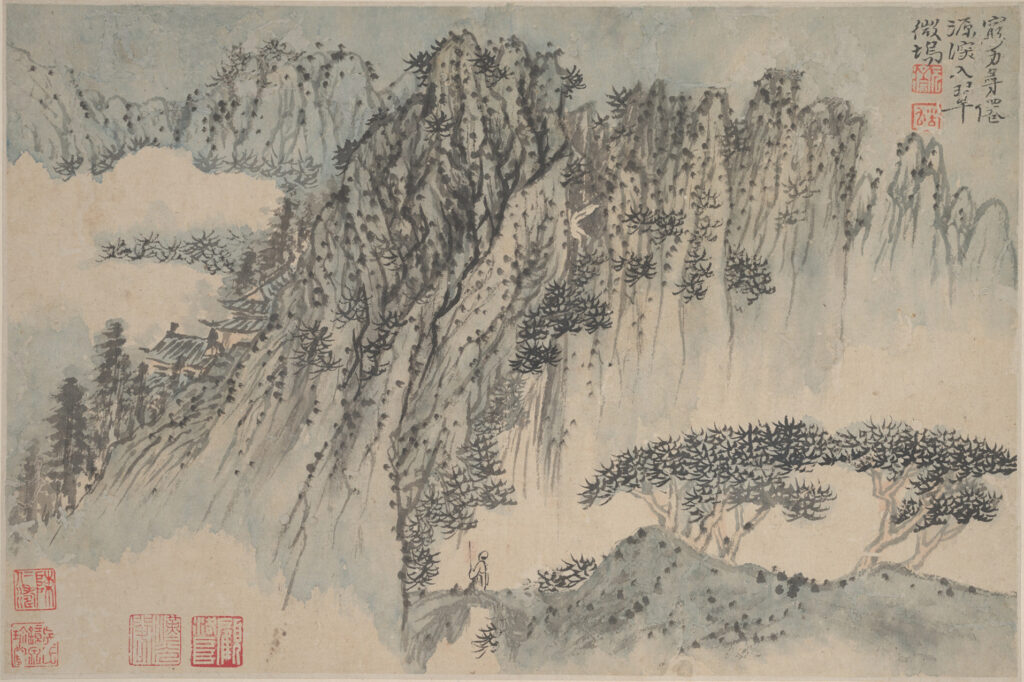
5. Personal identity and the meaning of human existence
There is a powerful and direct analogy between Shitao’s written views on art and his painted works, as they both reflect, complete, and perpetuate each other.
Moreover, a careful study of Daoji’s life path, as seen through his extant writings, suggests the portrait of a man constantly afflicted by the question of his own identity and the meaning of his existence on this earth. According to François Cheng, Shitao suffered the “trifold loss of the father: loss of his physical father, loss of the dynasty to which he was attached, and finally, loss of his spiritual master, which he was compelled to ‘forsake’ when he renounced his monastic position towards the midst of his life”1. More examples may be found by sifting through his letters and the inscriptions he left on some of his works.
These facts may help us to better understand Shitao’s evident preoccupation not only with the underlying principles of painting, but with the principles, origin, and meaning of Life itself, which he actively explored during his entire existence on this earth through the eye of painting. A meticulous reading of his treatise clearly demonstrates that Daoji’s philosophy of painting is but an extension of his philosophy of life, and that both seek to explain the meaning of his own existence. One might say that Shitao tried to answer both in writing and painting Paul Gauguin’s three questions D’où venons-nous? Que sommes-nous? Où allons-nous? (Where Do We Come From? What Are We? Where Are We Going?).
In order to paint properly — that is, to create a painting animated by the same Life principles that underlie and regulate the universe —, one must first gain a deep understanding of the self and of the gifts one has received from Heaven. Shitao first introduces this point in the fourth chapter of the Huayulu :
“然貴乎人能尊,得其受而不尊,自棄也;得其画而不化,自縛也。”2
“Therefore, the most important thing for man is to know how to venerate: for he who is unable to venerate the gifts of his perceptions wastes himself in pure loss, just as he who has received the gift of painting, but neglects to recreate, is reduced to helplessness.”3
He touches again on the same subject in Chapter XV :
“画乃人之所有,一画人所未有。夫画貴乎思,思其一則心有所著,而快所以画,則精微之入,不可測矣。”4
“Anyone can paint, but no one possesses the one-stroke, for the essence of painting lies in thought. Hence, thought must first embrace the One so that the heart can create and rejoice; only under these conditions will painting be able to penetrate the essence of things and reach the imponderable.”5
Shitao greatly expands his views a little further, in Chapter XVII, in which he expounds the one-stroke concept as being the common origin of Chinese painting and calligraphy (shufa 书法), a passage which may remind one of Kandinsky’s remarks on the geometric point6 :
“一画者,字画先有之根本也,字画者一画后天之經权也。能知經权而忘一画之本者,是由子孙而失其宗支也。能知古今不泯而忘其功之不在人者,亦由百物而失其天之授也。天能授人以法,不能授人以功;天能授人以画,不能授人以变。人或棄法以伐功,人或離画以务变。是天之不在于人,虽有字画,亦不傳焉。天之授人也,因其可授而授之,亦有大知而大授,小知而小授也。所以古今字画,本之天而全之人也。”7
“The one-brush is the root and primary origin of calligraphy and painting. Painting and calligraphy are the variable application of the one-brush. Who would remember only the application and forget the one-brush that is the origin thereof is like one who considers only the descendants whilst forgetting his ancestry. Who would know only the permanence of the ages, but would forget that the merit does not belong to men, allows himself to be drawn in the flow of things and loses the heavenly gift.
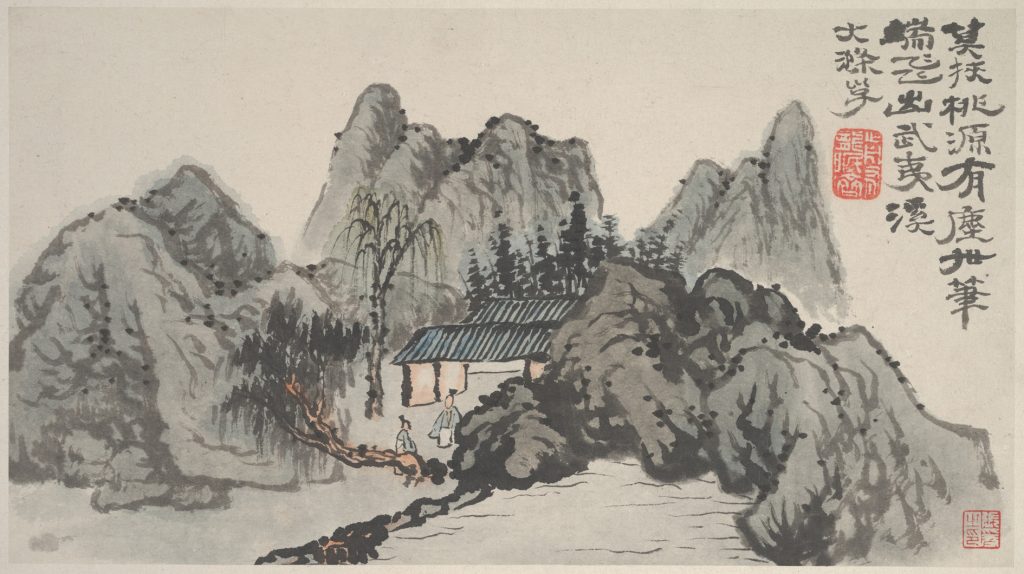
Album leaf, ink and colour on paper
21 x 31.4 Metropolitan Museum of Art
Heaven invests man with the rule, but it cannot invest him with its completion; Heaven invests the man with painting, but it cannot invest it with pictorial creation. If man abandons the rule to take care only of conquering its fulfilment, if man neglects the principle of painting in order to immediately attach himself to create, then Heaven is no longer in him; and though he write and paint with all his might, his work will not hold.
Heaven gives to man to the extent in which man is able to receive; the gift is great for those who have great wisdom; the gift is mediocre for those who have mediocre wisdom. Thus, the origin of calligraphy and painting has always been heavenly, while its completion is human.”8
As already stated above, painting according to Shitao is far from being a mere physical or even intellectual activity. Its origins do not lie in its techniques or in its history, gradually accumulated through the accomplishments of past generations of painters. The very act of painting emulates the creation of the universe and functions according to the same principles.
Hence, only a man endowed with a high level of self-cultivation, aware of the painterly gifts bestowed upon him by Heaven9, and conscious of who he is and what Heaven has destined him to do, is able to grasp the one-stroke concept and thus become a fully accomplished painter. He does so, not through personal merit or will, but because he has come to understand the role assigned to him by Heaven within Creation. As long as he develops the talents he has received and uses them according to the principle of Life, the value of his acts will keep on increasing. If, on the other hand, he misuses the gifts bestowed upon him, not only will the fruit of his actions be worthless, but he might even end up losing what he had received in the first place.
Shitao’s words come surprisingly close to those of Jesus Christ in His parable of the talents, as recounted by Matthew the Apostle (25:14-30) : talents are not given out by God at random, but to each man according to his abilities. With talents comes also the responsibility to put these to good use. For those who have honoured the burden assigned to them, there is also the promise of the increase of one’s talents and duties (compare Jesus Christ’s words, “For unto every one that hath shall be given, and he shall have abundance”, with Shitao’s : “亦有大知而大授”). As for those who have misused their gifts, or simply refused to use them, there is the warning of punishment, which may include the loss of one’s talents.
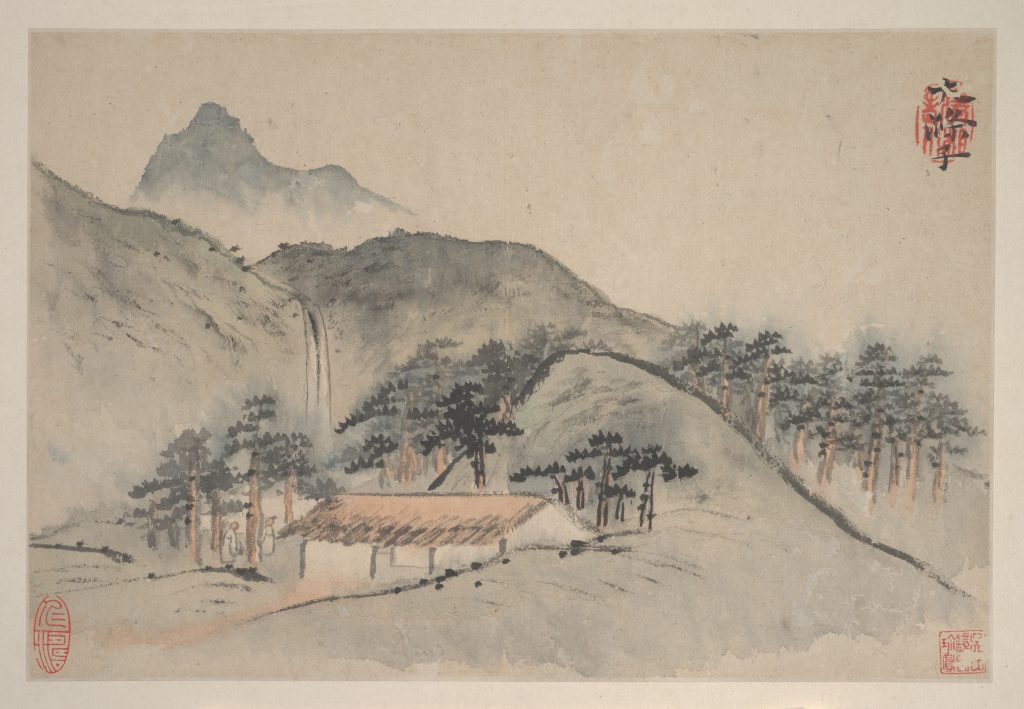
6. From rule to non-rule
Whether in Daoji’s treatise or Matthew 25:14-30, a man’s actions and the path he follows in life depend on his talents and on the understanding he has of them. To know one’s gifts means to know oneself; to know oneself means to know the meaning and purpose of one’s existence. Who knows the meaning and purpose of one’s existence is not far from grasping the secret of the origin of Life and is able to regulate his actions according to Life’s underlying principles. He who acts in this way, and not according to artificial human conventions, is, in Shitao’s words, able to “act through non-action” (wuwei er youwei 无为而有为). Once again, we may find an interestingly similar description offered by Jesus Christ to Nicodemus :
“The wind bloweth where it listeth, and thou hearest the sound thereof, but canst not tell whence it cometh, and whither it goeth: so is every one that is born of the Spirit.” (John 3:8, King James Version)
To wit, those who know God intimately need not apply and stiffly stand by the rules. As both their hearts and ways are in accordance with God, they will naturally satisfy the rules and adapt to any given situation.
The same principles apply to Chinese mountains-and-waters painting, and here, there arises a new analogy, this time with a conclusion reached by Wassily Kandinsky with regard to the form used in a specific work of art :
“… das wichtigste in der Formfrage ist das, ob die Form aus der inneren Notwendigkeit gewachsen ist oder nicht.”10
“… the most important thing in the question of form is whether the form has grown out of the inner necessity or not.”11
Although Shitao expresses himself in quite different terms, yet the primordial role of the painter’s inner necessity (inneren Notwendigkeit) is evident in the Huayulu :
“古之人寄興於筆墨,假道於山川,……”12
“The ancients expressed their inner feelings through brush-and-ink, by the way of mountains and streams.”13
This idea is rendered with much greater strength in Chapter VII :
“縱使笔不笔,墨不墨,画不画,自有我在。盖以运夫墨,非墨运也;操夫笔,非笔操也;脫夫胎,非胎脫也。”14
“At this point, even though brush, ink, painting, everything were obliterated, the Self would keep on existing by itself. For it is I who expresses myself through ink, not the ink which is expressive by itself; it is I who draws with the brush, not the brush that traces by itself. I give birth to my creation, it is not my creation who could give birth on its own.”15
In other words, a painting is the outward expression of a painter’s inner necessity. How it should be created — whether it be in terms of subject matter, composition, texture strokes, or other — depends entirely on the painter’s inner disposition and needs. Such kind of creative process cannot rely on a fixed methodology, but can only be achieved through a highly developed sensibility (shou 受) and the constant observation (guancha 观察) of the universe. This is where the enlightened painter, having honed his talents and perfected his skills, forgets all previously mastered rules and begins to paint spontaneously and naturally (ziran 自然). More than a thousand years earlier, Jing Hao 荆浩 commented the painter’s creative act in the following terms :
“原子勤之,可忘笔墨,而有真景”16
“… only when you reach the state of forgetting the technical matters of brush and ink, do you achieve the real landscape painting…”17
We may also recall a sentence by Huang Binhong, in his essay Guohua zhi Minxue 国画之民学.
“自然就是法。”
“Creation itself is the rule.”
This does not imply that Daoji disdained the importance of rules in the painter’s learning stage. As mentioned earlier in the present essay, he asserts in the first three chapters of his treatise that as soon as any given form of order or system comes into being, there necessarily ensues the establishment of given rules. However, one must first learn to distinguish between the universe’s inherent rules and those that are man-made, and are thus derivates. More important than to discern between primary and secondary rules is to grasp the fundamental principles on which these rules have been made to rest. Only in this way may a painter come to transcend already established rules — that is, rules developed by earlier masters and which, over the ages, have been gradually absorbed into the traditional painting canon — and create a style truly his own. Who, in Shitao’s words, does not grasp the one-stroke concept, is bound to remain enslaved to rules he does not understand and can only follow blindly.
“一画明,则障不在目而画可从心。画从心而障自远矣。”18
“But when one understands the one-brush, one no longer wears blinkers and the painting proceeds from the mind. When painting flows from the mind, obstacles move aside.”19
This is why, although the painterly learning process begins with the study of classic masters and masterworks (shifa guren 师法古人), it can and must not tarry at this stage, but must swiftly move on to learning from nature itself (shifa zaohua 师法造化).
The conflict dividing these two concepts, as well as the dangers that afflict those who lose themselves in the blind pursuit of the ancients and their specific styles, have been addressed time and again by painters and critics throughout the ages, and represent an unavoidable topic which every generation needs to reassess. Even in the twentieth century, the great master Huang Binhong 黄宾虹 wrote to his friend Fu Lei 傅雷 :
“所謂師古人不若師造化,造化無窮,取之不盡。”20
“Hence the phrase that following the ancients is not the same as following nature, for the creativity inherent in nature is inexhaustible and the possibilities are endless.”21 (From a letter dated 4 June 1943.)
Daoji’s conclusion, that the non-method is the perfect man’s ultimate method (又曰:“至人無法”,非無法也,無法而法,乃为至法。22) finds a strong analogy in Kandinsky’s essay, Über die Formfrage :
“Und so genügt es, wenn man sagt: Alles ist erlaubt. Das heute Erlaubte kann doch nicht überschritten werden. Das heute Verbotene bleibt unerschütterlich stehen.
Und man sollte sich keine Grenzen stellen, da sie ohnehin gestellt sind.”23
“And so it suffices to say: everything is allowed. What is permitted today cannot be exceeded. What is forbidden today remains unfalteringly still.
And one should not set any limits, for they are set anyway.”24
Kandinsky’s context is slightly different, since he concentrates his discussion on the appropriate use of forms in painting, yet the guiding principles he proposes are akin in essence. The seemingly unlimited freedom he alludes to, is not the result of a state of pure chaos but rather due to the painter’s inherent knowledge of what and how to paint — a knowledge obtained from the painter’s response to the inner nature (lit., inner sound, from the German, inneren Klang) of all the things that surround him. When a painter finds himself endowed with such a penetrating sensibility, he must needs cast off all previously learned rules, lest these turn into a ball and chain.
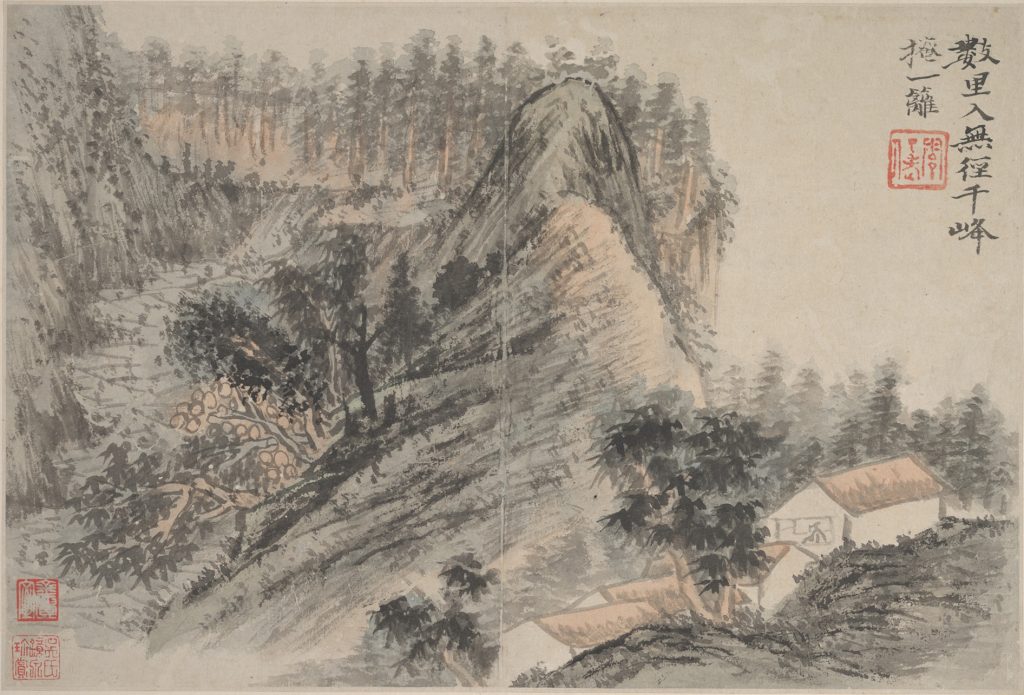
7. Transformation in art
“古者識之具也。化者識其具而弗为也。”25
“Antiquity is the instrument of knowledge. To transform consists in understanding this instrument without, however, becoming its servant.”26
Shitao explicitly refuses to worship the ancient masters and treat their art as an unattainable, lofty ideal. No one should learn from the ancients for the mere sake of it, and the past reveals its value only when it enriches the present (借古以开今). It may be worthwhile to compare Daoji’s reflections on the painter’s relation to past masters and artworks with those of Kandinsky :
“Jedes Kunstwerk ist Kind seiner Zeit, oft ist es Mutter unserer Gefühle.
So bringt jede Kulturperiode eine eigene Kunst zustande, die nicht mehr wiederholt werden kann. Eine Bestrebung, vergangene Kunstprinzipien zu beleben, kann höchstens Kunstwerke zur Folge haben, die einem totgeborenen Kinde gleichen. Wir können z. B. unmöglich wie alte Griechen fühlen und innerlich leben. So können auch die Anstrengungen, z. B. in der Plastik die griechischen Prinzipien anzuwenden, nur den griechischen ähnliche Formen schaffen, wobei das Werk seelenlos bleibt für alle Zeiten.”27
“Every work of art is the child of its age and, in many cases, the mother of our emotions. It follows that each period of culture produces an art of its own which can never be repeated. Efforts to revive the art-principles of the past will at best produce an art that is still-born. It is impossible for us to live and feel, as did the ancient Greeks. In the same way those who strive to follow the Greek methods in sculpture achieve only a similarity of form, the work remaining soulless for all time.”28
It is senseless to painstakingly copy and create paintings in the manner of such ancient masters as, let us say, Ju Ran 巨然, Fan Kuan 范宽 or Wu Zhen 吴镇. When Shitao refers to the “ancients”, he does not mean all the painters of past eras but only those who had succeeded in grasping the underlying principles of all things, who had transcended all existing rules, and who, by transforming everything they had learned and absorbed, had thus come to develop their own art. As we are given to understand that the art of any of the great ancient masters is the direct result of a very personal walk of life, it becomes obvious that trying to appropriate it can only yield lifeless results.
In the third chapter of the Huayulu, Shitao goes even further in his reflections when he argues that the gift of painting is natural (tianran 天然, i.e., not human) and that he sees no obligation whatsoever in revering the ancients and mechanically copying their works. The study of past masters should only derive from a painter’s inner necessity, to wit from the inner knowledge that such an activity will allow him to obtain something new, profitable to his own artistic pursuit. Here, there transpires the implication that there is in fact no obligation to study the ancients, should one find out that such an activity would not bear positive results. On this point, Shitao seems to have been marked by seemingly conflicting ideas. At the beginning of Chapter III, he acknowledges antiquity as being the means to knowledge, but at the end of the same chapter, he makes it clear that the gift of painting itself comes from an entity superior to everything human and that, should his work resemble that of a past master, it is the latter who happens to follow him, and not the opposite (縱有时触著某家,是某家就我也,非我故为某家也。). This last bold statement should not be merely interpreted as an artistic flight of fancy. It reminds us of the atemporality of the work of art and of the fact that similar forms may reoccur in art at different intervals, without being necessarily interlinked. We may thus deduce that Shitao’s remarks on antiquity and the study of the ancients are only apparently conflicting. The man of good (junzi 君子) is allowed to draw nourishment from the past, inasmuch as he is able to absorb it and put it to good use. The same principle applies to the study of the ancients. Which master should one study? And how? These are questions that the gifted and enlightened painter is able to answer intuitively, based on the knowledge of his own gifts and needs.
Transformation in art is but the natural and inevitable consequence of the painter’s creative act. In Shitao’s own words :
“凡事有經必有权,有法必有化。一知其經,即变其权;一知其法,即功于化。”29
“Anything that possesses constants must needs have variables. If there is a rule, there must be change. Based on the knowledge of the constants, one may set about modifying the variables; as long as one knows the rule, one must strive to transform.”30

8. Towards the infinite
“L’œuvre d’art est une tentative vers l’unique, elle s’affirme comme un tout, comme un absolu, et, en même temps, elle appartient à un système de relations complexes. Elle résulte d’une activité indépendante, elle traduit une rêverie supérieure et libre, mais on voit aussi converger en elle les énergies des civilisations.”31
“A work of art is an attempt to express something that is unique, it is an affirmation of something that is whole, complete, absolute. But it is likewise an integral part of a system o highly complex relationships. A work of art results from an altogether independent activity; it is the translation of a free and exalted dream. But flowing together within it the energies of many civilizations may be plainly discerned.”32
Henri Focillon’s words offer a quite accurate definition of Shitao’s artistic ideal, as well as of the Huayulu itself. The carefully composed treatise begins at the very roots of Life, travels through the myriad elements of art (in this case, Chinese mountains-and-waters painting), and finally comes to rest where it had begun, enriched by a lifetime of reflections and meditation.
Daoji’s vision and constant searching, as expressed in his treatise, may be described as twofold on more than one level. His pursuit is artistic as well as metaphysical, a journey that took him back to the very roots of art and Life, while at the same time allowing him to touch the infinite and catch a glimpse of eternity. His artistic vision proceeds from and is inextricably linked to his own existence and life experience, thus causing it to become a philosophy of life as much as of art. François Cheng correctly remarked that there exists no clear distinction between Shitao’s artistic theory and practice, as these form an organic whole, completing and extending each other at will33.
At the end of the eighteenth chapter, Daoji himself brilliantly expressed the scope of his endeavours in a few, well-chosen sentences :
“任不在笔,則任其可傳;任不在墨,則任其可受;任不在山,則任其可静;任不在水,則任其可动;任不在古,則任其無荒;任不在今,則任其無障。…… 然則此任者,誠蒙养生活之理,以一治万,以万治一。不任于山,不任于水,不任于笔墨,不任于古今,不任于聖人。是任也,是有其資也。”34
“The work does not reside in the brush, which allows it to be transmitted; it does not reside in the ink, which allows it to be perceived; it does not reside in the mountain, which allows it to express immobility; it does not reside in the water, which allows it to express movement; it does not reside in antiquity, which allows it to be limitless; it does not reside in the present, which allows it to be blinder-free. […]
In truth, the work is based on the principle of discipline and life: to master multiplicity through the One, and to master the One from multiplicity. It does not resort to mountains, water, brush, ink, ancients, moderns, or saints. This is the true work, based on its own substance.”35
It is in the timelessness of these words that lies the value of Shitao’s Huayulu.
Each era, each generation brings about new ways of seeing and connecting with artworks, and our own understanding of Song or Yuan dynasty paintings certainly differs from that of, let us say, viewers from the Ming and Qing dynasties.
In our day, striving to resemble Shitao in form would naturally be senseless, and Shitao himself would, no doubt, strongly disagree with such an attempt. What we can do, however, is to borrow from the philosophical essence of the Huayulu, and, aware of who we are, of the gifts we have been endowed with, and of the direction we should follow in this life, absorb it into our own artistic vision, and transform it — not forcibly but naturally.

Read the full magazine
1 François Cheng. Vide et Plein, Les Éditions du Seuil, 1991, p. 121.
2 道济 [著] 俞剑华 [标点注释].《石涛画语录》;p. 5.
3 Pierre Ryckmans, p. 97 (personal translation of the original French text).
4 道济 [著] 俞剑华 [标点注释].《石涛画语录》;pp. 11-12.
5 Pierre Ryckmans, p. 131 (personal translation of the original French text).
6 Wassily Kandinsky. Punkt und Linie zu Fläche, München: Verlag Albert Langen, 1926, p. 19.
7 道济 [著] 俞剑华 [标点注释].《石涛画语录》;p. 12.
8 Pierre Ryckmans, p. 140 (personal translation of the original French text).
9 It may be worthwhile to note here that in Chinese, the word “talent” translates as tianfen 天分, that is, “something distributed by Heaven”.
10 Wassily Kandinsky. Über die Formfrage, p. 23, in: Wassily Kandinsky & Max Bill. Essays über Kunst und Künstler, Bern: Benteli Verlag, 1973 (3. Aulf.).
11 Personal translation.
12 道济 [著] 俞剑华 [标点注释].《石涛画语录》;p. 13.
13 Personal translation from the original Chinese text.
14 道济 [著] 俞剑华 [标点注释].《石涛画语录》;p. 7.
15 Pierre Ryckmans, p. 108 (personal translation of the original French text).
16 荆浩 [著] 王伯敏 [标点注译] 邓以蛰 [校阅].《标点注译 —— 笔法记》.北京:人民美术出版社,1963年
17 Kiyohiko Munakata. Ching Hao’s “Pi-fa-chi”: A Note on the Art of Brush, in: Artibus Asiae. Supplementum, Vol. 31, 1974, p. 16.
18 道济 [著] 俞剑华 [标点注释].《石涛画语录》;p. 4.
19 Pierre Ryckmans, p. 92 (personal translation of the original French text).
20《黄宾虹文集 · 書信編》. 上海:上海書畫出版社,1999年,p. 202.
21 Claire Roberts. Friendship in Art, Hong Kong: Hong Kong University Press, 2010, p. 67.
22 道济 [著] 俞剑华 [标点注释].《石涛画语录》;p. 4.
23 Wassily Kandinsky, Max Bill (ed. and comm.). Essays über Kunst und Künstler, pp. 25-26.
24 Personal translation from the original German text.
25 道济 [著] 俞剑华 [标点注释].《石涛画语录》;p. 4.
26 Pierre Ryckmans, p. 93 (personal translation of the original French text).
27 Wassily Kandinsky. Über das Geistige in der Kunst, München: Verlag R. Piper & Co., 1912, p. 3.
28 Wassily Kandinsky (tr. by Michael T.H. Sadler), Concerning the Spiritual in Art, The Floating Press, 2008, p. 22.
29 道济 [著] 俞剑华 [标点注释].《石涛画语录》;p. 4.
30 Pierre Ryckmans, p. 93 (personal translation of the original French text).
31 Henri Focillon. Vie des formes, Paris: Presses Universitaires de France, 1943.
32 Henri Focillon (tr. by C. B. Hogan & G. Kubler). The Life of Forms in Art, New York: Zone Books, 1989.
33 François Cheng, Vide et Plein, p. 123.
34 道济 [著] 俞剑华 [标点注释].《石涛画语录》;p. 14.
35 Pierre Ryckmans, p. 145 (personal translation of the original French text).
[1] Also referred to as Shitao Huayulu 石涛画语录 (Shitao’s Remarks on Painting) or Kugua Heshang Huayulu 苦瓜和尚画语录 (Remarks on Painting by the monk Bitter Melon).
[2] Wassily Kandinsky, Max Bill (ed. and comm.). Essays über Kunst und Künstler, Benteli Verlag, Bern, 1973 (3. Aulf.), pp. 17-47.
[3] Pierre Ryckmans. Les propos sur la peinture de Shi Tao — Traduction et commentaire. In: Arts asiatiques. Tome 14, 1966, p. 79.
[4] Earle J. Coleman. Philosophy of Painting by Shih-T’ao — A Translation and Exposition of his Hua-P’u, Mouton Pub-lishers, The Hague, 1978, p. 106.
[5] 道济 [著] 俞剑华 [标点注释].《石涛画语录》;北京:人民美术出版社;2019.5 (重印);p. 13.
[6] Earle J. Coleman, p. 33.
[7] The anteriority or posteriority of the two existing versions of Shitao’s treatise, the Huapu 画谱 and the Huayulu 画语录, is a matter of debate. The Belgian sinologist Pierre Ryckmans, for one, saw in the Huayulu the final and later ver-sion of the earlier and rudimentary Huapu.
For a discussion on the two existing versions of Shitao’s treatise, compare Earle J. Coleman’s Philosophy of Painting by Shih-T’ao (pp. 26-31) and Pierre Ryckmans’ Les propos sur la peinture de Shi Tao (p. 79).
[8] Pierre Ryckmans, p. 79.
[9] Personal translation of the original French text.
[10] Lin Yutang, p. 140.
[11] One of Shitao’s monastic names (faming 法名).
[12] Osvald Sirén. The Chinese on the Art of Painting, Schocken Books, New York, 1963, p. 182.
[13] Ibid.
[14] Ibid.
[15] 道济 [著] 俞剑华 [标点注释].《石涛画语录》;p. 81.
[16] Translation mine
[17] 道济 [著] 俞剑华 [标点注释].《石涛画语录》;p. 4.
[18] Earle J. Coleman, p. 118.
[19] 道济 [著] 俞剑华 [标点注释].《石涛画语录》;p. 7.
[20] Pierre Ryckmans, p. 107 (personal translation of the original French text).
[21] 道济 [著] 俞剑华 [标点注释].《石涛画语录》;p. 6.
[22] Earle J. Coleman, p. 122.
[23] Dadizi 大涤子, translated by Pierre Ryckmans as “Disciple of the Great Purity” (see P. Ryckmans, p. 104): one of the many surnames used by Shitao.
[24] See, for example, the already mentioned Jiezhou Xuehua Bian 芥舟学画编, by Shen Zongqian.
[25] 道济 [著] 俞剑华 [标点注释].《石涛画语录》;p. 13.
[26] Earle J. Coleman, p. 140.
[27] Lin Yutang, p. 153.
[28] 道济 [著] 俞剑华 [标点注释].《石涛画语录》;p. 4.
[29] Translation mine
